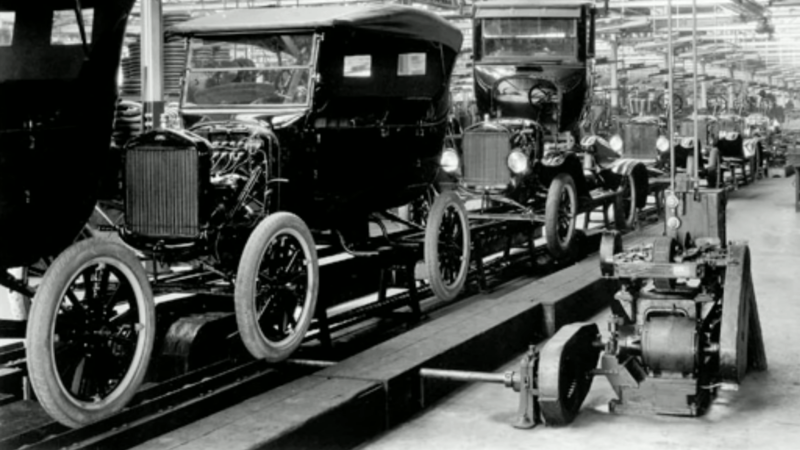Such colossal performance is largely due to the conveyor. But who invented and implemented this mechanism? The name of Henry Ford is the first to appear in the context of this device.
What is a conveyor?
Ozhegov's dictionary, the ubiquitous Wikipedia, and other reference books call a conveyor a continuously moving belt that moves workpieces from one worker to another. The conveyor transports loose, lumpy, piece items and materials.
 On the conveyor, each worker performs one operation. Photo: YouTube.com
On the conveyor, each worker performs one operation. Photo: YouTube.comA distinctive feature of such mechanisms is continuity. The mention of the first conveyors takes us several millennia back to Egypt, Mesopotamia, China and India, where water from natural sources for irrigation of fields was supplied by special devices. These were chain pumps, multi-bucket and screw water lifts, which became the prototypes of modern drag conveyors and elevators.
Hyml Goddard and Ransome Olds in the evolution of the assembly line
At the end of the XNUMXth and beginning of the XNUMXth centuries, the automotive industry began to develop rapidly. In the United States, auto plants have mushroomed. Each "self-propelled stroller" was exclusive - assembled by hand.
 A working model of a 1903 Oldsmobile. Photo: YouTube.com
A working model of a 1903 Oldsmobile. Photo: YouTube.comIn 1901, R. Olds founded the Olds Motor Vehicle Company. Here, assembling his famous Oldsmobile, the entrepreneur and inventor for the first time came up with the idea of bringing components and parts to each work point on special carts. Labor productivity increased many times, and the company began to produce 5 cars a year instead of 000 at the beginning of the journey. This was the first, albeit primitive, experience in the use of in-line production.
And in 1908, the talented engineer Heiml Goddard patented the roller conveyor. He did not invent, but improved a world-wide significant mechanism, the author of which cannot be found in the thousand-year history of mankind.
Henry Ford Automotive Production
The world knows H. Ford as a brilliant car manufacturer, a great entrepreneur. He, as they say, "kept his finger on the pulse" - he caught the best trends and innovations in the automotive industry, introduced advanced production methods.
 Henry Ford's factory is an empire of unprecedented proportions. Photo: YouTube.com
Henry Ford's factory is an empire of unprecedented proportions. Photo: YouTube.comAn extraordinary personality, he left the posterity to judge his deeds, aspirations and ways to achieve goals. Ambitions were high, dreams were large-scale, therefore, G. Ford left the most noticeable mark in the automotive industry.
Rightly extolling the merits of the creator of the automobile industry of unprecedented proportions, grateful descendants are ready to attribute to the industrialist all the achievements in this area. The conveyor for assembling a "self-propelled carriage" automatically entered Ford's "track record".
However, the assembly line method was adopted from a competitor, Ransom Olds. But the honor of implementing the invention of Heiml Goddard really belongs to the industrialist.
 Every 29 minutes, one car rolled off the Ford assembly lines. Photo: YouTube.com
Every 29 minutes, one car rolled off the Ford assembly lines. Photo: YouTube.comIn history, the memories of G. Ford's contemporaries have been preserved that he began to study the method of in-line production as early as 1903. Either legend or true, but there is information about a slaughterhouse in Chicago, where the future great manufacturer watched the work of butchers. The story was found in newspapers from the beginning of the last century, where it was reported that Ford was impressed by the method of butchering animal carcasses, when, observing the division of labor, each butcher did only one operation. But at the same time, it was not the worker who approached the carcass, but the animal, suspended on chains, was delivered to its “station”. This approach ensured high labor productivity.
Implementation of the assembly line at the Ford Motor Company
Until December 1913 (other sources give a more specific date - January 14, 1914), the production at the plant looked like this: chassis were in a row in the workshop, and workers installed attachments on them. Piece goods, made by hand, required a lot of time, highly skilled assemblers. The company suffered a large side loss of resources, so the car was expensive and was available only to the wealthy public. In this way, the release of the legendary "Model T" - "Lizzie's Tin" took place.
 The car that became "people's". Photo: YouTube.com
The car that became "people's". Photo: YouTube.comMeanwhile, Henry Ford intended to make automobiles available to the middle class - "to put America on wheels." To do this, it was necessary to reduce the cost of the product, so he calculated the potential of Heiml Goddard's invention and improved the innovation.
The mechanism - a roller belt conveyor - was first tested on generators. The technological process was divided into 29 operations: the time for manufacturing a unit of goods was reduced from 20 to 13 minutes. Later, there were 84 operations, and now the assembly of one generator fit in just 5 minutes.
 On the conveyor, the chassis was “overgrown” with attachments. Photo: YouTube.com
On the conveyor, the chassis was “overgrown” with attachments. Photo: YouTube.comWhen the pilot project was successful, the assembly line was used to assemble the machines. The chassis now stood on a mechanized belt that moved at a speed of 2 meters per minute. As we moved from one worker to another, the skeleton of the future car "overgrown" with body parts, wheels and other elements, of which there were 3 thousand in the design.
The successful implementation of the production line at the Ford Motor Company resulted in a reduction in assembly time for the Tin Lizzie from 12 hours to 90 minutes. The price of the car dropped from $800 to $600 and then to $345. In 1927, a new car rolled off G. Ford's auto assembly line every 29 minutes. The total number of "Model T" reached 15 million units.
 Henry Ford in front of his 27 millionth car. Photo: YouTube.com
Henry Ford in front of his 27 millionth car. Photo: YouTube.comIn-line production reduced the cost of vehicles, reduced collateral losses, and created an incredible demand for products. The dream of the innovator, who became the author of 161 US patents, came true - each representative of the large middle class could save up for his own car.
At the same time, factory workers, who at first were offended by the prospect of monotonously doing the same operation on the line, soon began to receive decent wages - $ 5 a day. G. Ford reduced the work shift to 8 hours, in addition, employees rested 2 days a week and went on paid vacation. These measures were taken not under the pressure of the trade unions, but on the industrialist's own conviction: he respected the freedom of the individual, considered material prosperity to be the norm of life.
 When the newspapers announced the $5 Rule, a crowd of 10 job seekers gathered outside the factory gate. Photo: YouTube.com
When the newspapers announced the $5 Rule, a crowd of 10 job seekers gathered outside the factory gate. Photo: YouTube.comThe rational organization of labor, the standardization of mass production, which became possible with the use of the conveyor, received the economic term "Fordism". G. Ford collaborated with the young USSR: he had a hand in the construction of the Gorky Automobile Plant, the production of the Fordson-Putilovets tractor. The personnel of the Soviet car factories were trained by employees of Ford Motors.
Conclusion
To summarize: conveyors have been known to mankind for several millennia. The inventor of the roller device, on the principle of which all modern car factories work, is considered the American engineer Heimel Goddard.
The method of in-line production of machines was first used by R. Olds. And Henry Ford adapted the assembly line for the assembly of cars, confirming the title of technological genius, not unreasonably given to him by his descendants.










